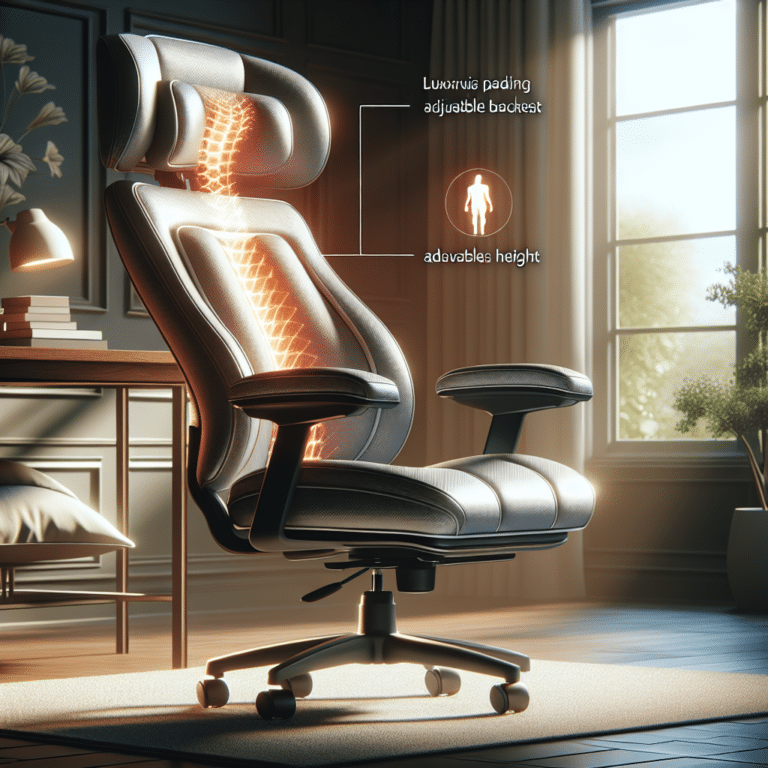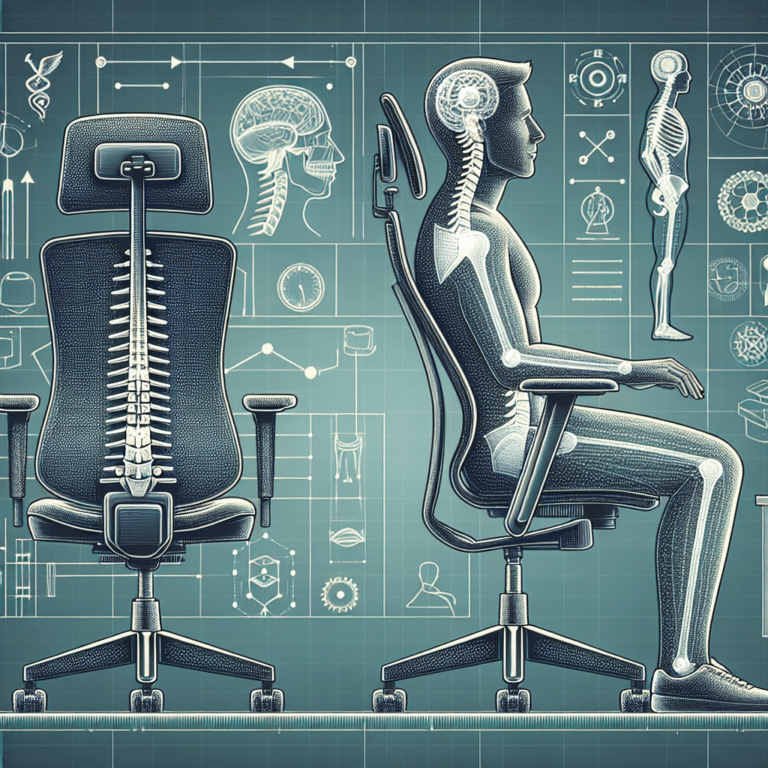10 Ways To Improve Posture With An Ergonomic Chair
Are you tired of experiencing back pain and discomfort during long hours of sitting? Look no further! In this article, you will discover 10 effective ways to improve your posture by incorporating an ergonomic chair into your daily routine. Say goodbye to slouching and hello to a healthier, more comfortable way of sitting. Whether you’re working from home or in an office setting, these simple tips will help you make the most out of your ergonomic chair and reap the benefits of improved posture.
Understanding Ergonomic Chair Adjustments
Recognizing chair features and their purposes
When it comes to understanding ergonomic chair adjustments, it’s essential to familiarize yourself with the different features and understand their purposes. Ergonomic chairs often have adjustable armrests, lumbar support, seat height, seat depth, and tilt mechanisms. Each of these features is designed to promote comfort, support, and proper alignment of the body while sitting for extended periods.
Learning about lumbar support customization
One of the key features of an ergonomic chair is lumbar support. The lumbar region of the spine, located in the lower back, often requires additional support to maintain proper posture. With lumbar support customization, you can adjust the chair’s curvature to fit your natural spine curvature, providing optimal support for your lower back. This adjustment helps prevent slouching and reduces strain on the lumbar spine.
Adjusting seat height and depth for optimal comfort
Proper seat height and depth are crucial for optimal comfort and posture. When adjusting the seat height, ensure that your feet are flat on the floor and your knees are at a 90-degree angle. This position promotes good circulation and prevents pressure on the backs of your thighs. Additionally, adjusting the seat depth allows you to support your thighs fully, avoiding undue pressure on the back of your knees.
Importance of armrest adjustments
Armrests play a significant role in reducing shoulder and neck tension while sitting. Proper armrest adjustments help maintain good posture and support the weight of your arms. Adjust the armrest height so that your forearms are parallel to the floor, allowing your shoulders to relax. Ensure the armrest width accommodates your natural elbow position, providing stability and reducing strain on your shoulders. It’s important to note that while armrests can be beneficial, it’s also essential not to rely on them too heavily while typing to encourage dynamic posture and movement.
Setting Up Your Workstation
Positioning your chair in relation to your desk
When setting up your workstation, it’s crucial to position your chair correctly in relation to your desk. Start by ensuring that the height of your chair allows you to sit with your feet flat on the floor and your knees at a 90-degree angle. This position promotes good posture and reduces strain on your lower back. Position your chair close enough to the desk so that you can comfortably reach your work materials without stretching or straining.
Ensuring appropriate eye-level with your monitor
Proper eye-level with your monitor is important to prevent neck and eye strain. Position your monitor at eye level, directly in front of you, to avoid tilting your head up or down. This alignment helps maintain a neutral position for your neck and reduces the risk of discomfort or injury. Adjust the monitor’s height or use a monitor riser if necessary to achieve the appropriate eye-level. Remember to position other frequently used items, such as your keyboard and mouse, within easy reach to minimize unnecessary stretching or reaching.
Organizing desk layout to reduce repetitive strain
An organized desk layout can significantly reduce repetitive strain on your body. Keep frequently used items, such as your phone or stationery, within easy reach to avoid unnecessary stretching or twisting. Consider using desk organizers or drawers to keep your workspace clutter-free and organized. Additionally, use a document holder to elevate any papers or documents you need to reference frequently, reducing strain on your neck and promoting better posture.
Incorporating footrests if needed
For individuals with shorter leg lengths or those who find it challenging to maintain proper posture with their feet flat on the floor, incorporating a footrest can provide additional support and comfort. A footrest helps elevate the feet to a comfortable position, reducing pressure on the lower back and aiding in proper circulation. Ensure that the footrest is adjustable in height to accommodate your specific needs, allowing for a natural and ergonomic sitting position.
Customizing Lumbar Support
Identifying your natural spine curvature
Before adjusting the lumbar support of your ergonomic chair, it’s important to identify your natural spine curvature. Stand in a relaxed posture and observe the curvature of your lower back. Some individuals have a more pronounced curve, while others may have a flatter back. Understanding your natural spine curvature will guide you in making the appropriate adjustments to the lumbar support.
Adjusting the lumbar support to fit your curve
Once you have identified your natural spine curvature, adjust the lumbar support of your chair to fit your curve. Most ergonomic chairs have a knob or lever that allows you to increase or decrease the lumbar support’s curvature. Gradually adjust the lumbar support until it comfortably supports your lower back without causing discomfort or pushing your spine into an unnatural position.
Balancing support between lower and mid back
When adjusting the lumbar support of your chair, it’s essential to achieve a balance between the support provided to the lower and mid back. The lumbar support should cradle the natural curve of your lower back without exerting too much pressure. At the same time, ensure that the support does not extend too far up your back, as this may cause discomfort in the mid-back area. Striking the right balance will promote proper spinal alignment and prevent strain or fatigue.
Frequency of readjustments for sustained comfort
It’s important to note that readjustments may be necessary periodically to maintain sustained comfort and support. As your body changes, or if you find yourself experiencing discomfort or pain, consider readjusting the lumbar support of your chair. Additionally, as you switch between different tasks or engage in activities that require different seated positions, such as typing versus reading, adjusting the lumbar support accordingly can enhance your overall comfort and prevent strain.

Optimizing Seat Depth and Height
Finding the right seat depth to support your thighs
The seat depth of your ergonomic chair plays a vital role in supporting your thighs and preventing pressure on the back of your knees. To find the right seat depth, ensure that there is a two-finger gap between the edge of the seat and the back of your knees. This gap allows for proper circulation and reduces the risk of developing discomfort or numbness. Adjust the seat depth accordingly to support your thighs fully without causing pressure or restricting movement.
Adjusting the seat height for level feet and knees
Proper seat height is essential for maintaining level feet and knees while sitting. Adjust the seat height so that your feet are flat on the floor and your knees are at a 90-degree angle. This position promotes good circulation, reduces fatigue, and prevents strain on your lower back and legs. If necessary, use a footrest to achieve the desired seat height and ensure optimal comfort and alignment.
Understanding the impact on circulation
Maintaining proper seat depth and height is crucial for optimal circulation while sitting. Inadequate seat depth can place excessive pressure on the back of your thighs, leading to reduced blood flow and potential discomfort. Similarly, incorrect seat height may result in poor circulation and increased pressure on your legs. By optimizing seat depth and height, you promote healthy circulation, reducing the risk of numbness, fatigue, and other circulation-related issues.
When to adjust based on task requirements
Different tasks may require different seated positions and, consequently, adjustments to seat depth and height. For example, tasks that involve prolonged typing may benefit from a slightly deeper seat depth to support the forearms effectively. Alternatively, tasks that require fine motor skills or closer proximity to the work surface may require a higher seat height. Understanding the specific requirements of each task and making appropriate adjustments can improve comfort, productivity, and overall posture.
Armrest Positioning for Shoulder Health
Adjusting armrest height to reduce shoulder tension
To reduce shoulder tension and maintain proper posture, it’s important to adjust the height of your armrests correctly. Start by adjusting the armrests so that your forearms are parallel to the floor when your shoulders are relaxed. This position allows your shoulders to rest comfortably and promotes a more neutral alignment of the upper body. Avoid having the armrests positioned too high or too low, as this can lead to tension and strain in the shoulders and upper back.
Ensuring armrest width accommodates natural elbow position
In addition to adjusting the height of the armrests, it’s crucial to ensure that the width of the armrests accommodates your natural elbow position. The armrests should be positioned close to your body, allowing your arms to rest comfortably without requiring excessive reaching or stretching. When the armrests are at the correct width, your shoulders and upper body can relax, minimizing the risk of shoulder and neck tension.
Avoiding overreliance on armrests while typing
While armrests can provide support and promote good posture, it’s important to avoid overreliance on them while typing. The primary purpose of armrests is to provide occasional support and help relax the shoulders and upper body during breaks or periods of rest. When actively typing or performing tasks, it’s beneficial to maintain a dynamic posture that allows for natural movement and engagement of the muscles. Alternate between resting your forearms on the armrests and allowing your arms to engage in a more active position to prevent muscle stiffness or fatigue.
Alternating armrest positioning periodically for dynamic posture
To encourage a dynamic posture and alleviate muscle fatigue, it’s advisable to periodically alternate the positioning of your armrests. Moving the armrests to different positions throughout the day helps engage different muscle groups and prevents static strain. For example, during breaks or periods of rest, you can position the armrests slightly higher or lower to encourage a change in posture. By incorporating these adjustments, you promote flexibility, blood circulation, and overall comfort.
The Role of Tilt Mechanisms
Leveraging chair tilt for movement throughout the day
Tilt mechanisms in ergonomic chairs are designed to allow for movement throughout the day, reducing the risk of static sitting and promoting blood circulation. Leveraging the chair tilt by occasionally tilting the seat or backrest can help alleviate pressure on specific areas of the body and encourage subtle movement while seated. From a seated-forward tilt, which engages your core muscles, to a reclined tilt for short breaks, the tilt mechanisms offer versatility and options to enhance comfort and overall posture.
Locking versus free-flowing tilt adjustments
Different ergonomic chairs may offer different types of tilt adjustments, including locking or free-flowing options. Locking mechanisms allow you to lock the chair in a specific tilt position, providing stability and control. On the other hand, free-flowing tilt adjustments allow for more natural movement and continuous shifting while seated. Understanding the options available with your chair and finding the right balance between stability and mobility can enhance your seated experience and overall posture.
Syncing chair tilt with your tasks and comfort level
Syncing the chair tilt with your tasks and comfort level is essential for optimal ergonomics. For tasks that require increased focus and precision, locking the chair tilt in an upright or slightly forward position can provide stability and promote concentration. Conversely, for tasks that allow for more relaxed movement, such as reading or brainstorming, adjusting the chair tilt to a reclined position can offer comfort and a change in posture. Experimenting with different tilt angles and observing how your body responds will help you find the most comfortable and supportive position for each task.
The benefits of a reclining position for short breaks
Incorporating short breaks throughout the day is crucial for reducing sedentary behavior and promoting overall health. During these breaks, reclining the chair tilt slightly can offer numerous benefits. A reclined position allows for stretching and relaxation of the muscles, especially in the lower back and hip area. It also promotes blood flow to the legs and feet, reducing the risk of swelling or discomfort. Taking advantage of the benefits of a reclining position during short breaks can help revitalize your body and maintain good posture for extended periods.
Importance of Regular Movement
Using the ergonomic chair’s mobility for posture shifts
One of the significant advantages of an ergonomic chair is its mobility, which allows for posture shifts and reduces the risks associated with prolonged static sitting. Throughout the day, make use of the chair’s mobility by occasionally adjusting the seat height, changing the tilt angle, or reclining during short breaks. These posture shifts help engage different muscle groups, promote blood circulation, and alleviate pressure on specific areas of the body, reducing the likelihood of discomfort or fatigue.
Incorporating stretch intervals throughout the day
In addition to utilizing the chair’s mobility, incorporating stretch intervals throughout the day is essential for maintaining good posture and overall well-being. Simple stretches that target the neck, shoulders, back, and legs can help relieve muscle tension, improve flexibility, and prevent stiffness. Stand up or take a moment to stretch and move your body at regular intervals, allowing for a reset and a break from prolonged seated positions. These stretch intervals not only benefit your physical well-being but also improve mental clarity and productivity.
Standing breaks and their effectiveness
While ergonomic chairs provide comfort and support, standing breaks offer additional benefits to your posture and overall health. Standing breaks help counteract the effects of prolonged sitting by engaging different muscle groups and promoting better blood circulation. Consider incorporating standing breaks at regular intervals throughout the day, such as during phone calls or when reviewing documents. Remember to maintain good posture while standing, avoiding slouching or leaning on objects for support.
Dynamic sitting for spinal health
Dynamic sitting involves continuously changing your seated position, engaging different muscle groups, and promoting spinal health. Rather than maintaining a fixed sitting position, dynamic sitting encourages movement and subtle shifts in posture. This can be achieved by incorporating posture-based exercises, such as pelvic tilts or shoulder rolls, or by simply adjusting your position throughout the day. By embracing dynamic sitting, you minimize the risk of developing muscle imbalances, enhance core strength, and promote a healthy spine.
Chair Material and Breathability
Selecting materials that promote airflow
When choosing an ergonomic chair, consider the materials used and their impact on breathability. Opt for chairs with breathable materials, such as mesh or perforated fabrics, as they allow air to flow freely, preventing heat build-up and promoting comfort. The ability of the chair materials to dissipate body heat contributes to a more pleasant sitting experience and reduces the likelihood of sweating or discomfort, particularly during long periods of sitting.
Impacts of temperature regulation on posture comfort
Temperature regulation plays a significant role in ensuring posture comfort while sitting for extended periods. Chairs that excel in temperature regulation maintain a comfortable seating environment, preventing overheating or feeling too cold. When the body is comfortable, it is easier to maintain a relaxed posture and focus on the task at hand. Consider the temperature regulation capabilities of the materials used in your ergonomic chair to ensure a pleasant sitting experience throughout the day.
Maintenance of the chair for long-term use
Proper maintenance of your ergonomic chair is essential for its long-term use and continued effectiveness. Regularly clean the chair according to the manufacturer’s recommendations to prevent dust, debris, or stains from compromising the chair’s functionality or appearance. Inspect the chair for any loose screws or bolts, and tighten them as necessary to maintain structural integrity. Lubricate any moving parts to ensure smooth functioning, and address any concerns promptly to prevent further damage or discomfort.
Considering seat padding for prolonged sitting
Seat padding is an important consideration, especially for individuals who require prolonged periods of sitting. Chairs with adequate seat padding offer additional cushioning, reducing pressure points and enhancing overall comfort. Look for chairs with high-quality foam or memory foam padding for optimal support and durability. The seat padding should strike a balance between softness and firmness, providing adequate support without sacrificing comfort. Ensure the padding remains intact and does not compress excessively over time to ensure sustained sitting comfort.
Incorporating Posture-Friendly Accessories
Use of ergonomic cushions for additional lumbar support
Ergonomic cushions are designed to provide additional lumbar support and enhance seated comfort. These cushions are often made from memory foam or similar materials that conform to the natural curve of the lower back, providing targeted support. If your ergonomic chair’s lumbar support is not sufficient or adjustable, consider incorporating an ergonomic cushion to improve your posture and prevent lower back discomfort. Choose a cushion with adjustable straps or fastenings to ensure it stays securely in place throughout the day.
Integrating seat wedges for pelvic tilt correction
Seat wedges are beneficial for individuals who require pelvic tilt correction to maintain proper posture while seated. These wedges are specifically designed to address pelvic alignment issues by tilting the pelvis slightly forward, promoting a more neutral and aligned position of the spine. Seat wedges can be particularly helpful for individuals who experience lower back pain or have a tendency to slouch while seated. Choose a seat wedge that suits your specific needs and ensure it is securely placed on your chair for optimal support.
Utilizing headrest attachments for neck support
Headrest attachments can provide additional support and promote proper alignment of the neck and spine. These attachments are designed to prevent forward head posture and reduce strain on the cervical spine. If your ergonomic chair does not come with an integrated headrest or if the existing headrest does not suit your needs, consider utilizing headrest attachments for improved neck support. Ensure that the headrest attachment is adjustable in height and position, allowing for customization to your specific requirements.
Selecting the right accessories to complement your ergonomic chair
When selecting accessories to complement your ergonomic chair, choose those that address your specific needs and promote optimal posture. Consider factors such as lumbar support, pelvic tilt correction, neck support, and emphasis on maintaining dynamic posture. Personalize your chair setup with the right combination of accessories to maximize your comfort, reduce strain, and enhance your overall posture and well-being.
Collaborating with Healthcare Professionals
Seeking advice from physiotherapists for personalized chair adjustments
Physiotherapists are healthcare professionals who specialize in musculoskeletal health and can provide personalized advice on chair adjustments. If you have specific concerns or require customized adjustments for your ergonomic chair, consider consulting a physiotherapist. They can assess your posture, identify areas of concern, and provide recommendations tailored to your unique needs. By collaborating with a physiotherapist, you can optimize your ergonomic chair setup and ensure that it effectively supports your individual body requirements.
Integrating recommended postural exercises
Postural exercises recommended by healthcare professionals, such as physiotherapists or occupational therapists, can complement the benefits of using an ergonomic chair. These exercises target muscle imbalances, improve core strength, and promote proper alignment of the spine. By incorporating recommended postural exercises into your daily routine, you can proactively enhance your posture, minimize the risk of discomfort or injury, and further optimize the benefits of your ergonomic chair.
Understanding ergonomic principles from occupational therapists
Occupational therapists specialize in promoting overall well-being and independence in daily activities, including ergonomics. Consulting an occupational therapist can provide valuable insights into ergonomic principles, ensuring that your chair setup aligns with your specific occupational requirements. They can offer guidance on proper body mechanics and adjustments that facilitate task performance while maintaining good posture. By understanding ergonomic principles from occupational therapists, you can optimize your chair setup for maximum comfort, productivity, and long-term health.
Regular assessments for postural improvement
Regular assessments with healthcare professionals, such as physiotherapists or occupational therapists, are essential for ongoing postural improvement. These assessments allow professionals to monitor your progress, identify areas that require further attention, and provide continual guidance and support. By establishing a routine of regular assessments, you can track your postural improvements over time, make necessary adjustments to your chair setup, and ensure that you continue to prioritize your posture and well-being.
In conclusion, understanding ergonomic chair adjustments and setting up your workstation properly can significantly improve your posture and overall well-being. By recognizing the features and purposes of an ergonomic chair, customizing lumbar support, optimizing seat depth and height, adjusting armrests, leveraging tilt mechanisms, incorporating regular movement and incorporating posture-friendly accessories, you can create a comfortable and ergonomic workstation that promotes good posture. Collaborating with healthcare professionals and conducting regular assessments further enhances the effectiveness of your ergonomic chair setup. With these 10 ways to improve posture with an ergonomic chair, you can achieve sustained comfort, prevent discomfort or injury, and enhance your overall productivity and well-being.








